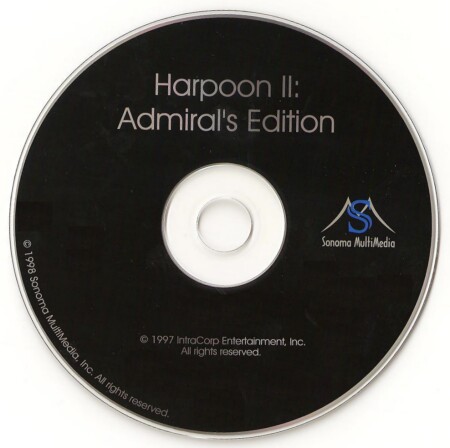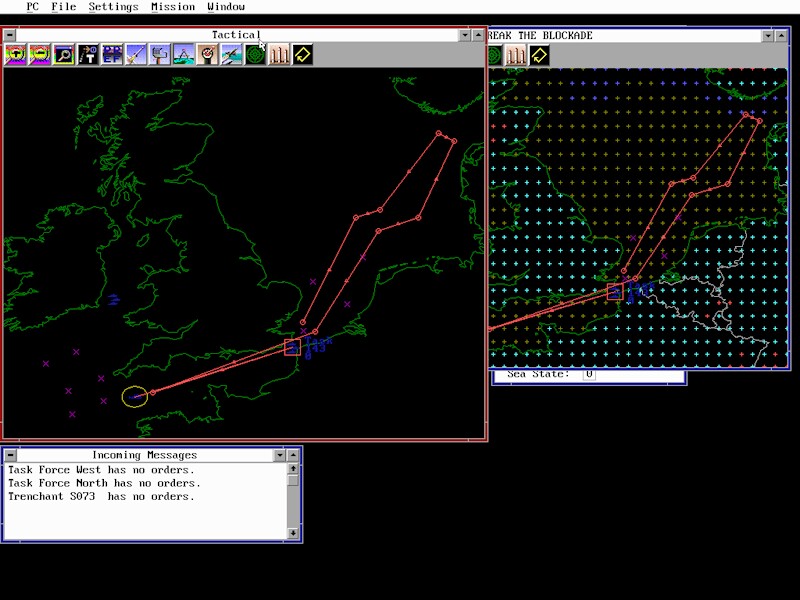
Actual Game
Harpoon II
|
The Game
The Admiral's Edition is the final release of Harpoon II and includes:
Harpoon II is a very detailed wargame simulating modern-day naval combat. You take the place of a theatre commander, in charge of various assets: ships, planes, and subs. The game runs 'clocked', where each second of your time represents as little as one second and as much as thirty minutes of game time - you can change this ratio at your desire, and pause it to give orders. The game is always one-player, you against the computer.
You play a game by choosing one of around a dozen scenarios, or one of seven tutorials. The tutorials are defintely worth playing through, a very well-designed set that does a good job of demonstrating nearly all the functionality of the game.
Once you finish the tutorials, on you go to the scenarios. The demise of the Cold War has made things difficult on lovers of modern-day wargames - 360 does a good job of surmounting this, giving you a plausible series of scenarios which are not all based on US vs. USSR (indeed, only one has this matchup). The majority are third-world flare-ups: a border squabble between Ecuador and Peru, a struggle in the Antarctic between Chile and Argentina, a battle between the US and North Korea, etc.
Once you pick a scenario, and a side to play in the scenario, you are allowed to pick a difficulty level. You can also 'custom-tailor' your difficulty, toggling various components to the setting you desire.
Pick a side to play, and off you go! The first thing you'll see is a 'main battle window' showing the overall tactical situation, and a bunch of other windows showing you the current time, current incoming messages, and so forth. A great feature of H2 is that it contains its own multi-windowing system - rather than continually frantically scrolling from your air base in the top left to your sub in the bottom right to your task force in the middle, you can spawn multiple windows, each with its own magnification level, each covering various parts of the battlefield. Another great feature of this is that you can assign a window to 'track' a particular unit - as the unit moves, the window automatically pans to keep the unit centered. Furthermore, you can decide for each window what sort of things you want displayed within in - you can decide whether or not to see weapon range arcs, land masses, latitude/longitude lines, and a host of other things.
As you look at the map, you'll usually see (depending on the preferences you've set for the window) a bunch of circles radiating out from your forces. There are 6 such circles per unit, showing the range of its air, surface, and submarine sensors as well as the range of its air, surface, and submarine weaponry. As you might imagine, the radii of these circles for various units are really the key dynamic driving the battle!
What forces are you dealing with? This 'force analysis' is another area where the game really shines, although it threatens to overwhelm you in detail. Click on one of your assets, say a ship, and you see in the 'unit status' window the name of the ship, it's type (FF, DD, etc.), its course/speed/bearing, and a few other things. If you click on the 'database' button, a window pops up giving you a one-paragraph description of the ship class, along with a little picture of the ship.
Aircraft have another layer of detail generally missing in ships and subs. Aircraft, even aircraft of a particular type, can have various types of armaments stuck on them. Rather than load each weapon on a plane one by one, each plane type has a series of 'bundles', called 'loadouts', of packages of armaments. For example, one loadout might be better for long- range ground strikes, while another might be best for air-to-air combat. You can control which loadouts you put on which planes.
You start the game by 'resuming' the clock - the game can crawl along as slowly as one second of your time to one second of game time (useful during intense combat), or as slowly as one second of your time to 30 minutes of game time. When a 'staff message' comes up, alerting you of some event (an enemy contact, say), the clock temporarily reverts to 1:1 - a very nice feature! There are no less than four ways you can control your units - individually, as a 'group', as part of a mission, or as part of a formation. The individual control is the simplest. Pick a unit, click on the 'navigate' icon, lay out a path for it, and off it goes. You can take a bunch of units and 'group' them, into a naval task force for example. All the controls which worked for the individual units can now be applied to the group as a whole. A more complicated but powerful way to control units is to create a mission. There's around ten types of missions (naval strike, anti-sub patrol, air reconaissance, etc.). When you create a mission, you can then assign various units of yours, be they air, surface, or sub, to that mission, and off they go! Finally, you can take a group of naval units and edit their 'formation' - which ships are near the edge of the formation, which are focusing on anti- sub pickets, which are focusing on anti-air CAP, etc.
Once you've given your units orders, they'll go their merry way, and it probably won't be too long before you're fighting some enemy units. Two nice features of the game help keep you from getting too overwhelmed in detail here. Firstly, you can set 'weapons free', which allows units to use their own initiative when firing weapons - you don't have to scurry from plane firing each weapon yourself. Secondly, you can also toggle a 'weapons allocation' option, under which you still fire the weapons, but the computer tells you which weapons it recommends that you fire.
There are many more features in the game - mid-air refueling, logistics, steerable missiles, active/passive/intermittent sensors, and on and on, but I think what I've described is enough to give you an overall feel for the game.
The game has huge amounts of detail and is well-presented. I can do no better than paraphrase G.B. Shaw - this is the kind of game you'll like, if you like this sort of game.




